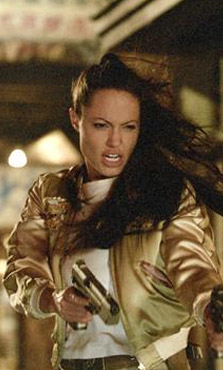 Now that summer blockbusters are being made about theme park rides, cinema purists will welcome “Tomb Raider 2” with tears of gratitude as a reminder of those halcyon days when feature films were adapted from video games. Indeed, Paramount clearly values history and pedigree, finding inspiration for their new property by going back not only to Alexander the Great, but deep into the Hollywood equivalent of the pre-Cambrian era: the year of our Lord 1982, the Golden Age of Spielberg. Now that summer blockbusters are being made about theme park rides, cinema purists will welcome “Tomb Raider 2” with tears of gratitude as a reminder of those halcyon days when feature films were adapted from video games. Indeed, Paramount clearly values history and pedigree, finding inspiration for their new property by going back not only to Alexander the Great, but deep into the Hollywood equivalent of the pre-Cambrian era: the year of our Lord 1982, the Golden Age of Spielberg.
After all, if the writers of “Tomb Raider 2” deserve any special praise, it is for their staunch refusal, in the face of such annoying hinderances as conscience and professionalism, to avoid any and all chances to steal wholesale from “Raiders of the Lost Ark”. Lines of dialogue (“The box is not meant to be found”), characters (MI6 cronies/Department of Defense suits), objects (Pandora’s box/God’s ark, key/medallion), and gruesome deaths (villain’s acid bath/Nazi face-melting) are all plundered shamelessly. The rip-offs are “homages” the way blatant CIA fabrications are “sexed-up intelligence reports”.
“Tomb Raider 2” contains a few perverse joys, nevertheless. For one, the film is a skin flick for weapons pervs. Its technological obsession (read: phallus worship) rivals that of the Bond franchise. But the knives and guns are more than props to be ogled, they are the syntactical units in Lara’s autistic language of violence; apparently the good Lady only uses boring old spoken words as a last resort. When Lara’s hard drives are spinning about something, which is almost always, those around her shouldn’t hold their breath for a conversation. Instead they’ll get a briefing in blades, a lecture in bullets, perhaps a secret conferred in fists. When Lara wants to recommend a book for one of her helpers to read, she flings a razor-sharp bamboo stick into the wall just above it. Imagine asking her to pass the salt at dinner.
The joke about gonzo action movies of the 80s, the ones whose artillery budgets exceeded the GDPs of tiny Central American republics, was that none of the guns ever ran out of ammunition. Our muscled hero would walk through a crowd of bad guys, usually at the pace of a casual Sunday-morning stroll, mowing them down by the dozens without stopping for a reload. Boldly upending this convention, the filmmakers of “Tomb Raider 2” are obsessed with the transcience of ammo. They are cartridge fetishists (“Gather ye machine gun clips while ye may”). Reloading occurs in voluptuous slow motion, her clips falling out in perfect synchronization, as if to say “All empty”, the way a child opens its mouth to verify that the spinach has been swallowed. After awhile it seems Lara fires three or four shots and swaps out a half-empty clip just for the hell of it. You begin to wonder if her gunfights aren’t about killing bad guys but actually a form of tantric foreplay.
Proving an appropriate match, the villain in “Tomb Raider 2”, in current bogeymen fashion, is an arms dealer who specializes in selling biological weapons to terrorists. To throw us off the scent, but not far off, his name is not Rumsfeld but Rice. Like Lara, he is a virtuoso of the gratuitous gesture. We find this out early on when he bumps off a business partner who has cut a deal to hand him over to British Intelligence. Method? Oh, just a bit of Ebola virus. Talk about risk of blowback! Lady Croft is forced to kill him later in the movie, no doubt wanting to avoid explaining to her manservants why a Nobel Prize-winning scientist managed to bloody her lip.
Besides its dogged dedication to overkill, this multinational, pancorporate production does know a thing or two about traveling. “Tomb Raider 2” visits an appealing variety of locales, proving that evil henchmen are as poor at marksmanship in rural China or Central Africa as they are everywhere else. Jolie is the perfect star for such a film, seemingly committed to becoming not only the world’s foremost sex object but also its purest war machine. With the robotic sheen of her skin, the three or four facial expressions she can muster, and the wide-eyed intensity with which she stalks her prey, she is the true Terminatrix, a twenty-first century killing machine who is all about delivering pain and deferring pleasure.
In the touching farewell she gives to her lover at the end, she resembles Darryl Hannah’s replicant, her CPU overloading with impossible humanity, at the end of “Blade Runner”. In this sense, the film is perfectly loyal to its video game source, and Jolie probably deserves praise for voiding herself to reach the status of a hollow digital caricature. But to call that a success only renders the proceedings moot. Staring down at Pandora’s box, the treasure still closed, its tempting glow lighting up her vacant eyes, Jolie’s blankness was eloquent. After all the fuss, who cares if she opens Pandora’s box or not? The worst has already gotten loose in the world. |